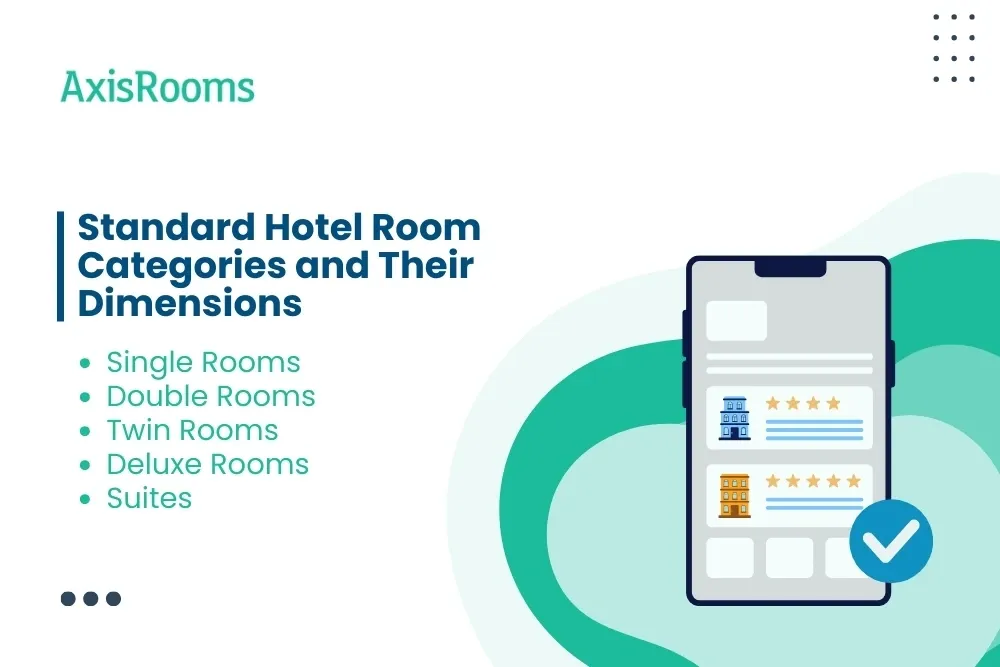Hotel room size significantly influences guest comfort, operational efficiency, and a hotel’s market appeal. While travelers seek cozy or spacious rooms depending on their needs, hoteliers must optimize space for ROI and guest satisfaction. This guide explores global room size trends, influencing factors, standard dimensions, and evolving design practices.
1. What Influences Hotel Room Sizes?
Room sizes are not arbitrary—they are shaped by external constraints and strategic business decisions.
a. Location & Region
In dense urban centers like Tokyo or London, limited space and high property prices push hotels to offer smaller rooms, often relying on creative layouts to compensate. In contrast, suburban and rural areas provide ample land at lower costs, allowing for more spacious rooms with generous layouts. Cultural expectations also play a key role—American guests expect large, open rooms, while European and Asian travelers are more accustomed to compact, efficient designs.
b. Hotel Type and Star Rating
Budget hotels prioritize basic amenities and affordability, offering rooms between 150–200 sq ft to maximize space and revenue. Mid-range hotels increase room size and add comfort elements like work desks, larger bathrooms, or better views, generally offering 200–350 sq ft. Luxury hotels focus on high-end experiences, with rooms starting at 400 sq ft and often exceeding 1000 sq ft for suites, including premium amenities and bespoke design.
c. Target Audience
Business travelers usually prioritize function over form—compact rooms with ergonomic workspaces and strong Wi-Fi are ideal for them. Families seek larger rooms or interconnected options to accommodate children and luggage comfortably. Couples and honeymooners value ambiance, privacy, and luxury, even if it means less space. Solo travelers are often more flexible, preferring value-for-money and functional designs in smaller rooms.
2. Standard Hotel Room Categories and Their Dimensions
Each room category serves a specific guest type, balancing size, functionality, and experience.

a. Single Rooms
Perfect for solo travelers, these rooms typically measure 90–120 sq ft and include a single bed, compact bathroom, and basic amenities. They are designed for efficiency, especially in business-focused or high-density city hotels.
b. Double Rooms
Sized between 150–200 sq ft, these are ideal for couples or two guests, offering a double bed or twin beds, a desk, and standard storage. They strike a balance between affordability and comfort, making them the most commonly booked type.
c. Twin Rooms
Similar in size to double rooms, twin rooms include two separate beds and cater to business travelers, siblings, or friends traveling together. These rooms offer versatility without increasing the square footage significantly.
d. Deluxe Rooms
At 250–400 sq ft, deluxe rooms are more spacious and aesthetically upgraded with better furnishings, lighting, and sometimes balconies. Ideal for long-stay guests or travelers seeking more comfort without the cost of a suite.
e. Suites
- Junior Suites (400–600 sq ft): Feature a semi-separated living and sleeping area, often with lounge seating and premium décor.
- Executive Suites (600–900 sq ft): Offer distinct bedroom and living spaces, ideal for business executives or luxury travelers.
- Presidential Suites (1000+ sq ft): The epitome of luxury, with multiple rooms, kitchenettes, private terraces, and concierge services.
3. Regional Variations in Hotel Room Sizes
Room sizes vary across regions based on geography, architecture, and guest expectations.
a. North America
Standard hotel rooms in the U.S. average 300 sq ft and offer full-sized bathrooms, desks, and often lounge areas. Luxury rooms frequently exceed 500 sq ft, catering to American preferences for space and comfort.
b. Europe
With space at a premium in cities like London or Paris, room sizes average 215 sq ft and may go as low as 150 sq ft. Hotels use clever designs—like foldable furniture or combined bathroom-wardrobe areas—to make rooms functional and stylish.
c. Asia
In places like Hong Kong and Tokyo, budget hotels offer ultra-compact rooms (as small as 100 sq ft), while luxury hotels provide more space (250–400 sq ft). International brands in Southeast Asia tend to offer larger rooms to cater to Western guests and long-haul tourists.
4. Designing for Comfort: Optimizing Small Spaces
Design plays a crucial role in enhancing guest experience, especially when working with limited room dimensions.
a. Balancing Space with Functionality
Smart layouts use built-in or wall-mounted furniture, saving precious floor area without compromising on utility. Sliding doors reduce dead space around bathrooms and closets, while under-bed storage keeps the room clutter-free. Maintaining a clear walkway helps the room feel larger and more welcoming.
b. Smart Layout Techniques
Open-plan layouts that combine sleeping and lounge zones reduce the need for separate rooms. Large windows, glass partitions, and mirrors visually expand smaller spaces and bring in natural light. Zoned lighting—such as reading lights, ambient lights, and task lights—helps break the room into functional areas.
5. Hotel Room Design Trends to Watch
As lifestyles evolve, so do hotel room designs—trending toward minimalist, tech-savvy, and sustainable living spaces.

a. Micro-Hotels
These offer ultra-compact rooms (60–100 sq ft) that focus on smart design, comfort, and technology rather than space. They appeal to solo travelers, millennials, and those who prioritize location and price over size. Brands like Pod Hotels, Yotel, and CitizenM are leading the trend with tech-integrated, community-driven experiences.
b. Sustainability in Room Design
Smaller rooms reduce environmental impact by lowering energy, water, and cleaning costs per guest. Designers are using eco-friendly materials, modular furniture, and energy-efficient lighting to build greener hotels. Sustainability also enhances brand perception and appeals to modern, conscious travelers.
6. Technology for Room Category Management
b. Category-Based Pricing - With Axisrooms, hotels can implement a comprehensive Hotel Revenue Strategy for different room sizes and categories, maximizing revenue by adjusting rates based on occupancy trends and market conditions. This ensures both competitive positioning and profitability while maintaining rate parity across channels.
Conclusion: Room Size—A Crucial Element in Travel & Hospitality
Whether you're traveling for business or building your dream hotel, room size matters more than you think. Travelers should choose room types that align with their needs—solo, couple, family, or business. Hoteliers must use room size strategically to balance guest satisfaction, operational costs, and market demand. Well-designed rooms, regardless of size, deliver comfort and drive repeat business.
Travelers: Have you stayed in a room that was unexpectedly small or surprisingly spacious? Share your experiences—did room size make or break your trip?
Hoteliers: Are your current room layouts optimized for guest satisfaction and profitability? Use this guide to rethink space, enhance design, and future-proof your property.


